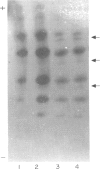Abstract
A subject deficient in the seventh component of complement (C7) was plasmapheresed with 660 ml C7-sufficient plasma. The expected reconstitution of C7 activity, followed by exponential decay, was not observed. During day 1, serum haemolytic C7 and total haemolytic complement were undetectable and C7 levels were very low by C7 ELISA. However, low levels of circulating fluid phase terminal complement complex (TCC) were detected. On day 2 about microgram C7/ml serum was detected and this rose to 6 micrograms/ml by day 17. Functional complement activity was also present. At day 28 the serum C7 and total haemolytic complement had dropped to pretransfusion levels. A low level of C5b6 was present in pretransfusion serum and this increased markedly immediately following transfusion when the patient's serum also acquired C7 consuming activity. Throughout the study low levels of anti-C7 antibodies were present but there was no evidence that antibody was directly responsible for the C7 consumption. Nevertheless antibody-antigen interactions could have generated circulating C5b6. C5b6 has been shown previously to have the capacity to inhibit C7 activity in vitro. Investigations of the C7 circulating on days 2-17 demonstrated normal molecular weight, functionally active C7. The donor sera and the recirculating C7 allotyped C7-1 by isoelectric focusing; however, the recirculating C7 showed additional weak bands with C7 functional activity, suggesting a possible genetic or acquired abnormality. Although the disappearance of C7 immediately post-transfusion may be explained by the presence of C5b6, there is no satisfactory explanation for the rising C7 levels on days 2-17 and we cannot exclude temporary C7 secretion by the patient.
Full text
PDF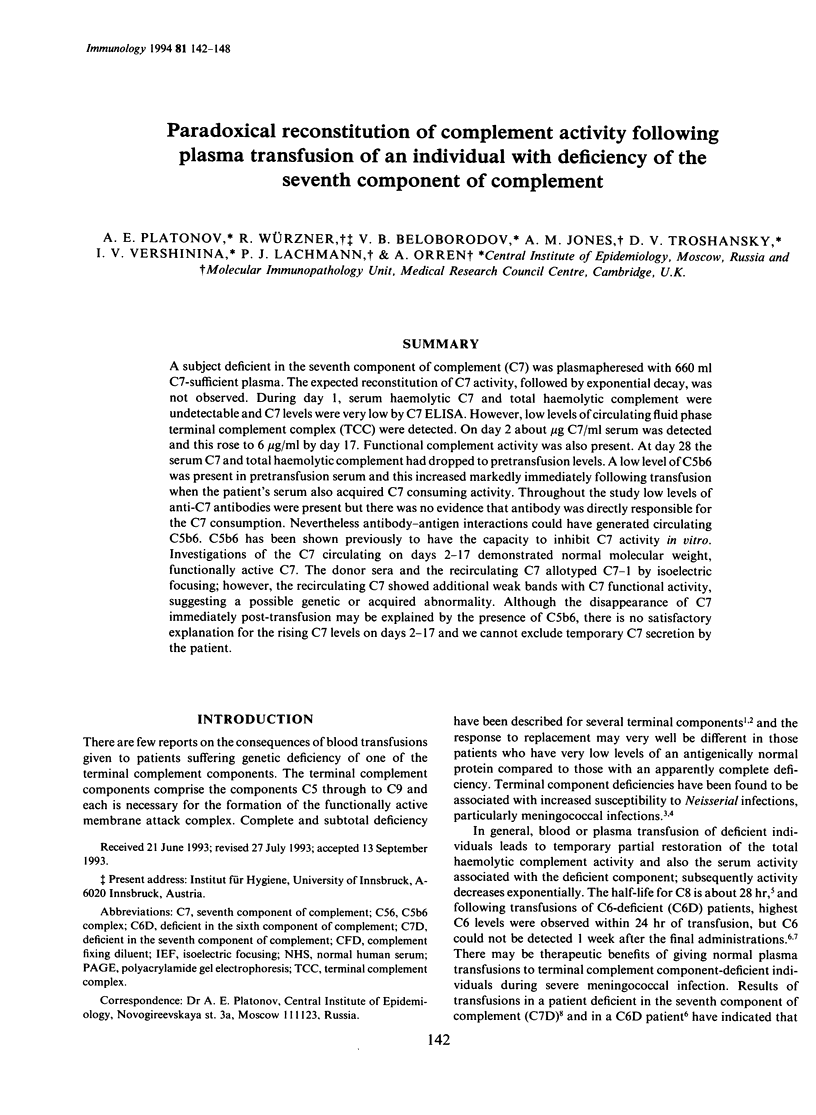
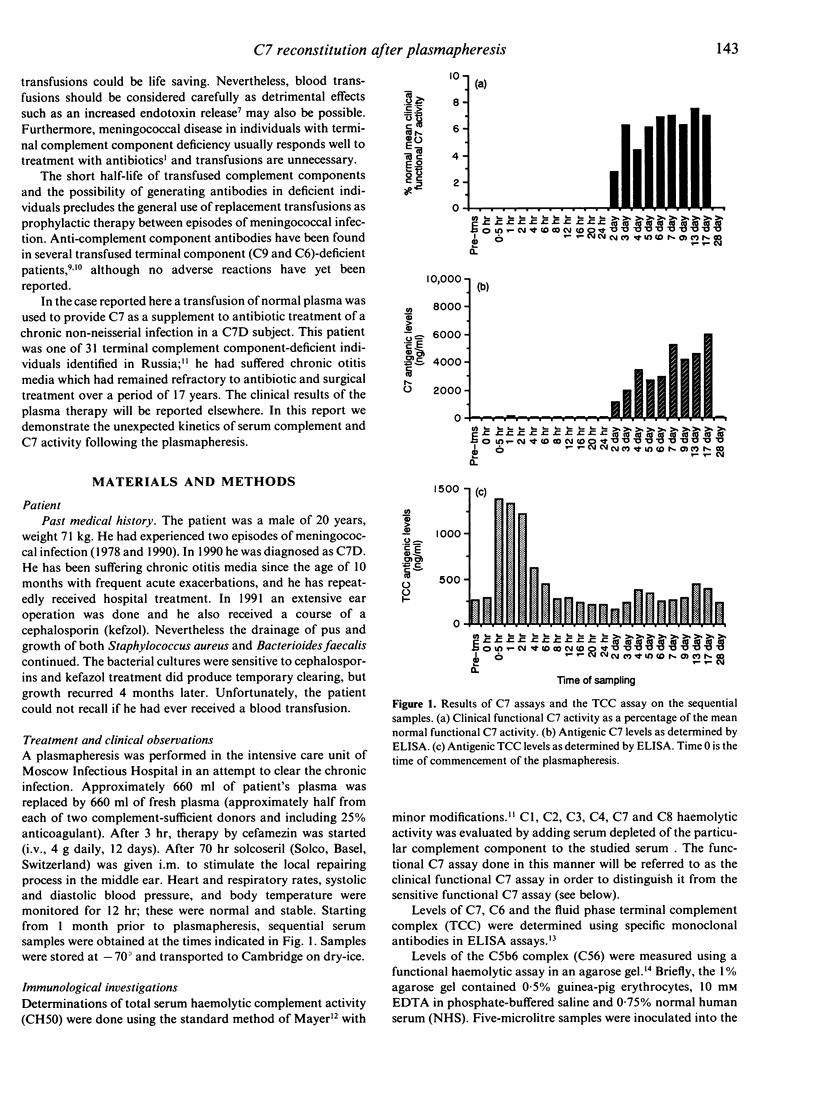
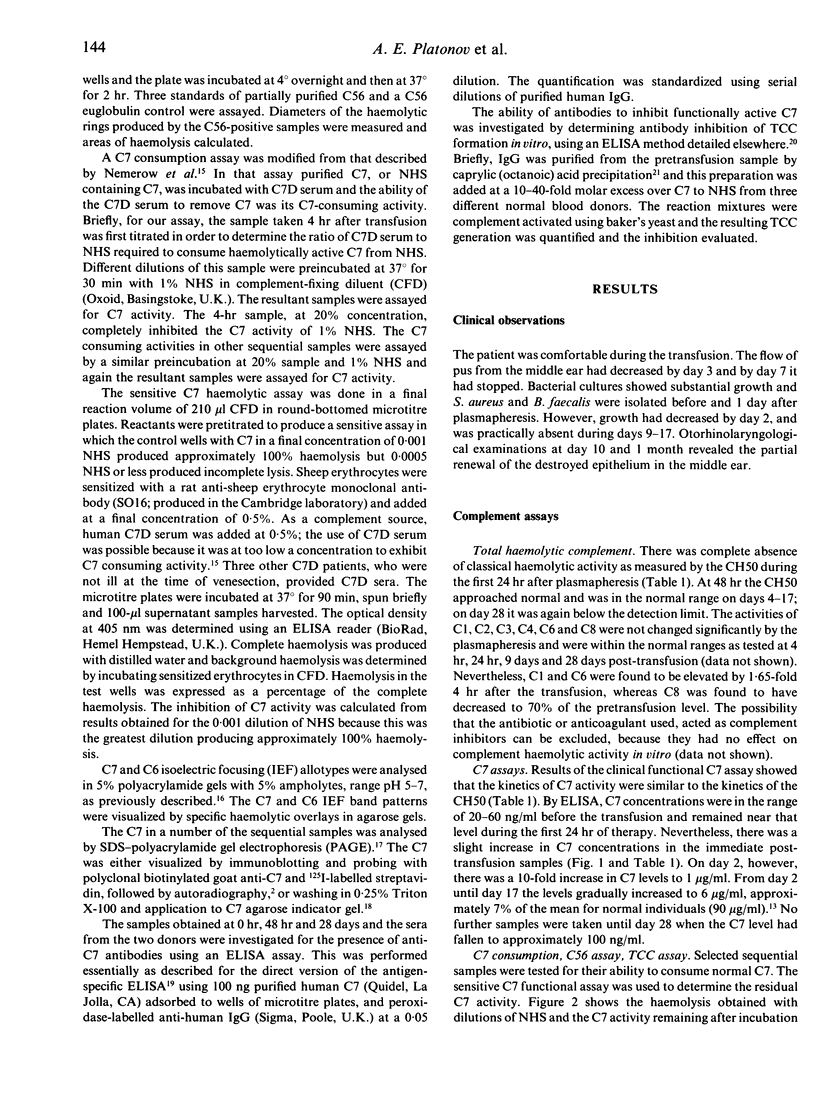
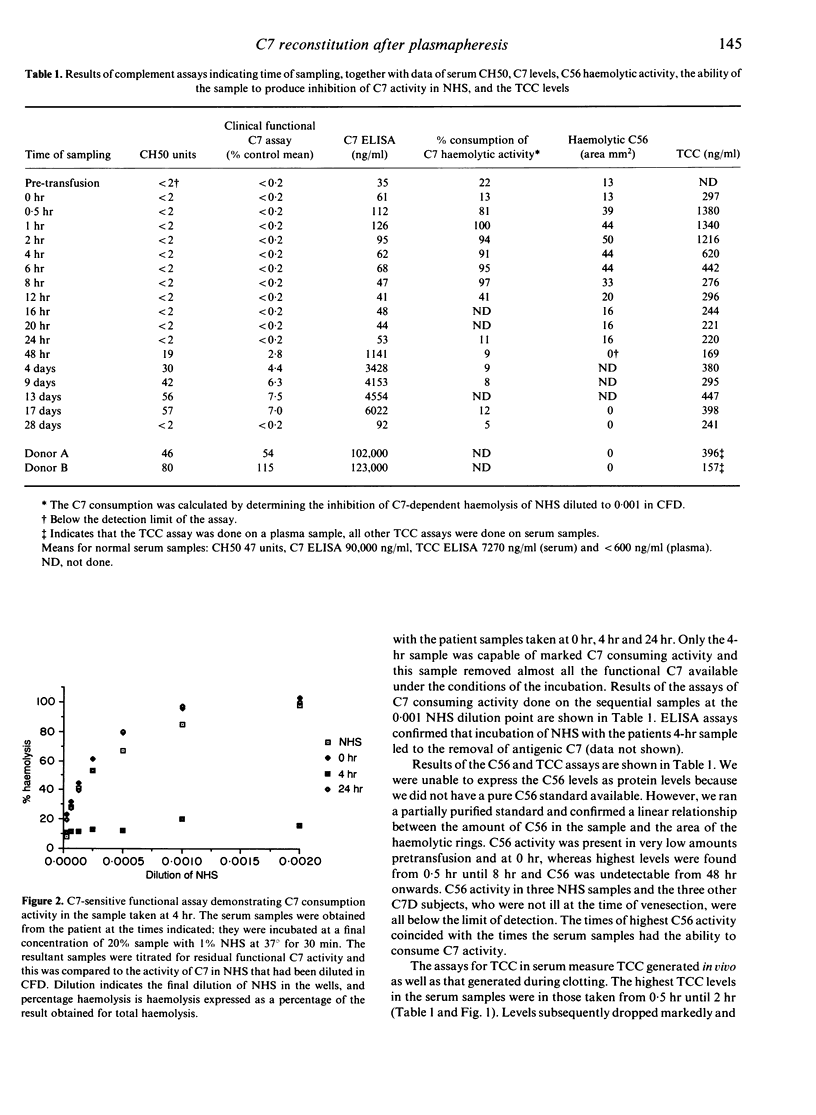
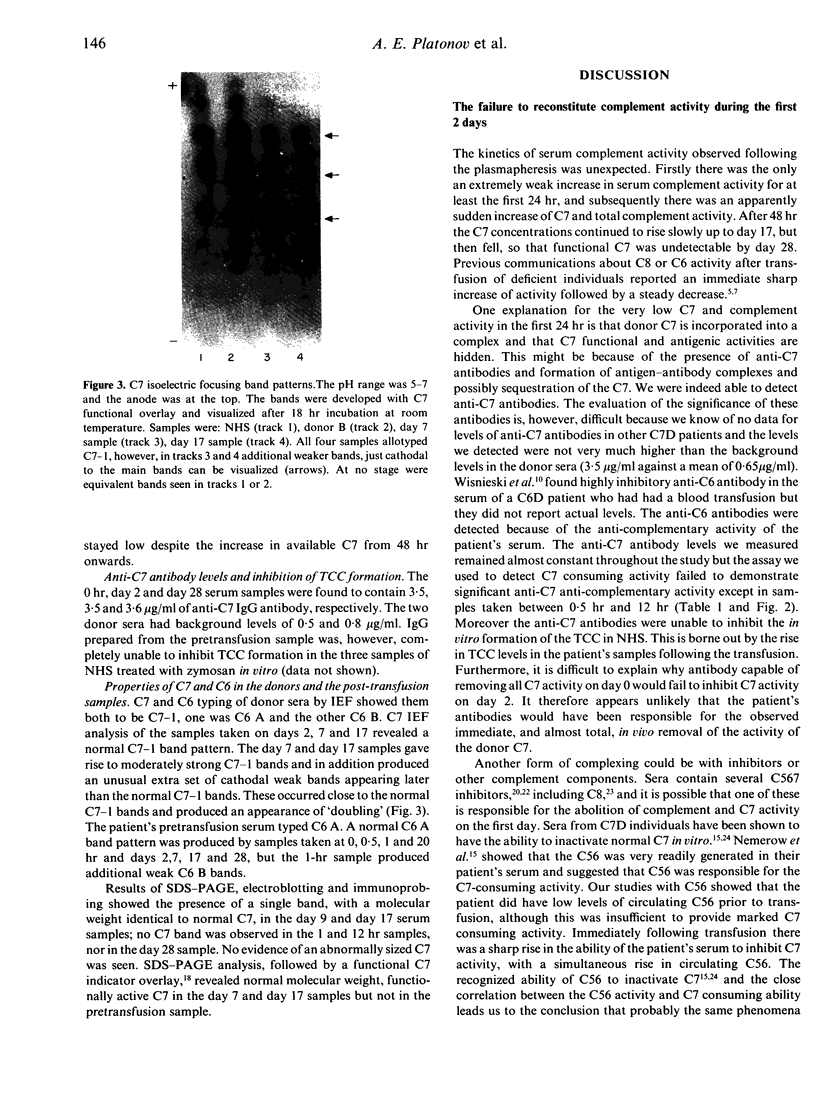
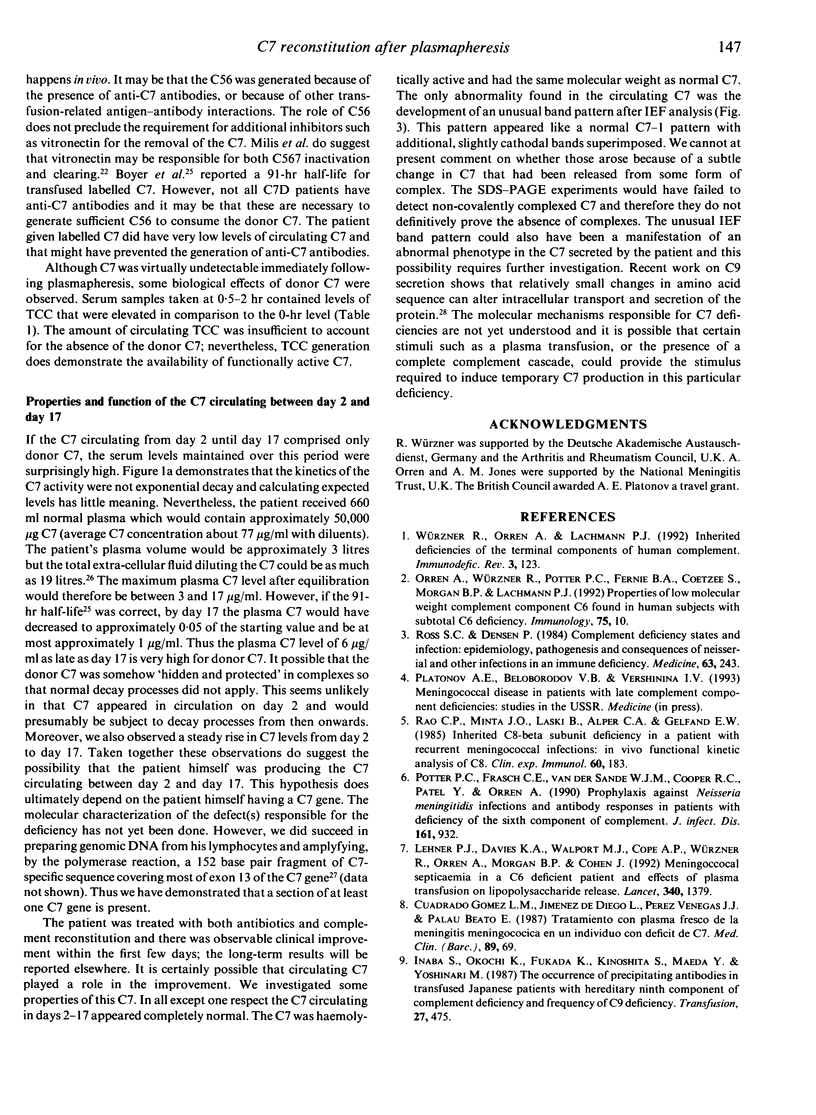
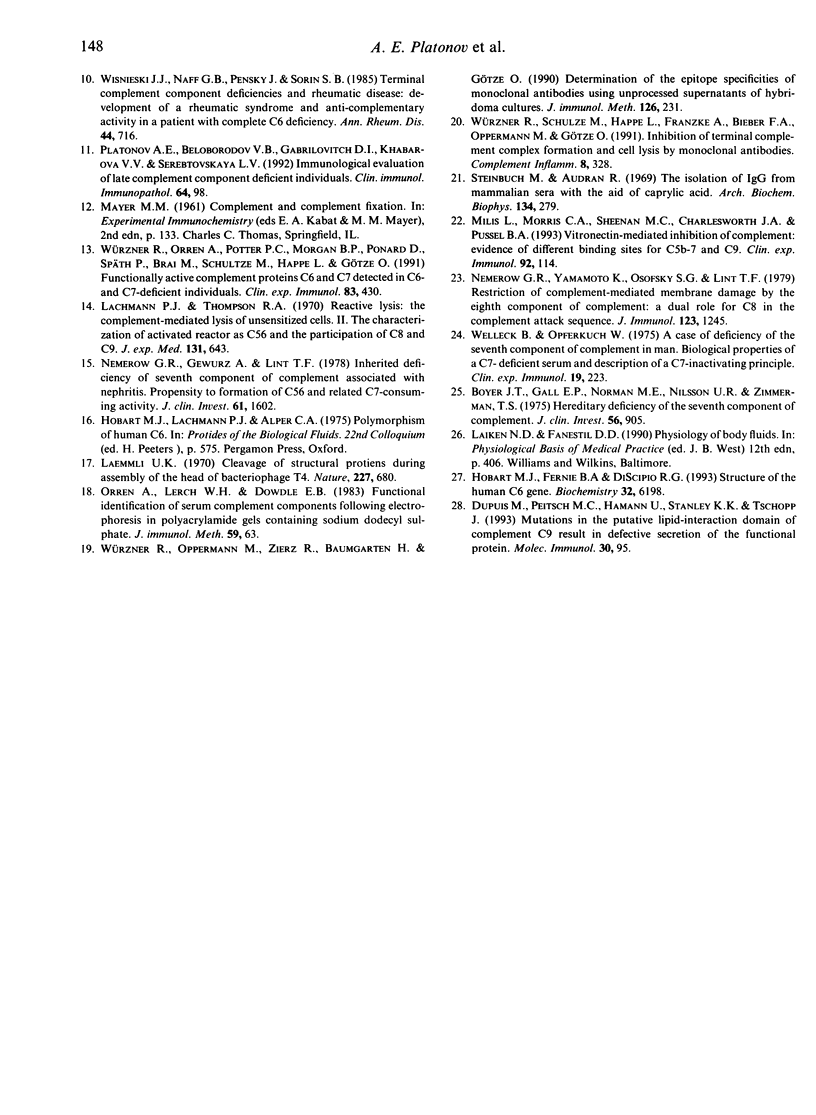
Images in this article
Selected References
These references are in PubMed. This may not be the complete list of references from this article.
- Boyer J. T., Gall E. P., Norman M. E., Nilsson U. R., Zimmerman T. S. Hereditary deficiency of the seventh component of complement. J Clin Invest. 1975 Oct;56(4):905–913. doi: 10.1172/JCI108170. [DOI] [PMC free article] [PubMed] [Google Scholar]
- Hobart M. J., Fernie B., DiScipio R. G. Structure of the human C6 gene. Biochemistry. 1993 Jun 22;32(24):6198–6205. doi: 10.1021/bi00075a012. [DOI] [PubMed] [Google Scholar]
- Inaba S., Okochi K., Fukada K., Kinoshita S., Maeda Y., Yoshinari M. The occurrence of precipitating antibodies in transfused Japanese patients with hereditary ninth component of complement deficiency and frequency of C9 deficiency. Transfusion. 1987 Nov-Dec;27(6):475–477. doi: 10.1046/j.1537-2995.1987.27688071698.x. [DOI] [PubMed] [Google Scholar]
- Lachmann P. J., Thompson R. A. Reactive lysis: the complement-mediated lysis of unsensitized cells. II. The characterization of activated reactor as C56 and the participation of C8 and C9. J Exp Med. 1970 Apr 1;131(4):643–657. doi: 10.1084/jem.131.4.643. [DOI] [PMC free article] [PubMed] [Google Scholar]
- Laemmli U. K. Cleavage of structural proteins during the assembly of the head of bacteriophage T4. Nature. 1970 Aug 15;227(5259):680–685. doi: 10.1038/227680a0. [DOI] [PubMed] [Google Scholar]
- Lehner P. J., Davies K. A., Walport M. J., Cope A. P., Würzner R., Orren A., Morgan B. P., Cohen J. Meningococcal septicaemia in a C6-deficient patient and effects of plasma transfusion on lipopolysaccharide release. Lancet. 1992 Dec 5;340(8832):1379–1381. doi: 10.1016/0140-6736(92)92561-s. [DOI] [PubMed] [Google Scholar]
- Milis L., Morris C. A., Sheehan M. C., Charlesworth J. A., Pussell B. A. Vitronectin-mediated inhibition of complement: evidence for different binding sites for C5b-7 and C9. Clin Exp Immunol. 1993 Apr;92(1):114–119. doi: 10.1111/j.1365-2249.1993.tb05956.x. [DOI] [PMC free article] [PubMed] [Google Scholar]
- Nemerow G. R., Gewurz H., Osofsky S. G., Lint T. F. Inherited deficiency of the seventh component of complement associated with nephritis. Propensity to formation of C56 and related C7-consuming activity. J Clin Invest. 1978 Jun;61(6):1602–1610. doi: 10.1172/JCI109080. [DOI] [PMC free article] [PubMed] [Google Scholar]
- Nemerow G. R., Yamamoto K. I., Lint T. F. Restriction of complement-mediated membrane damage by the eighth component of complement: a dual role for C8 in the complement attack sequence. J Immunol. 1979 Sep;123(3):1245–1252. [PubMed] [Google Scholar]
- Orren A., Lerch W. H., Dowdle E. B. Functional identification of serum complement components following electrophoresis in polyacrylamide gels containing sodium dodecyl sulphate. J Immunol Methods. 1983 Apr 15;59(1):63–71. doi: 10.1016/0022-1759(83)90146-1. [DOI] [PubMed] [Google Scholar]
- Orren A., Würzner R., Potter P. C., Fernie B. A., Coetzee S., Morgan B. P., Lachmann P. J. Properties of a low molecular weight complement component C6 found in human subjects with subtotal C6 deficiency. Immunology. 1992 Jan;75(1):10–16. [PMC free article] [PubMed] [Google Scholar]
- Potter P. C., Frasch C. E., van der Sande W. J., Cooper R. C., Patel Y., Orren A. Prophylaxis against Neisseria meningitidis infections and antibody responses in patients with deficiency of the sixth component of complement. J Infect Dis. 1990 May;161(5):932–937. doi: 10.1093/infdis/161.5.932. [DOI] [PubMed] [Google Scholar]
- Rao C. P., Minta J. O., Laski B., Alper C. A., Gelfand E. W. Inherited C8 beta subunit deficiency in a patient with recurrent meningococcal infections: in vivo functional kinetic analysis of C8. Clin Exp Immunol. 1985 Apr;60(1):183–190. [PMC free article] [PubMed] [Google Scholar]
- Ross S. C., Densen P. Complement deficiency states and infection: epidemiology, pathogenesis and consequences of neisserial and other infections in an immune deficiency. Medicine (Baltimore) 1984 Sep;63(5):243–273. [PubMed] [Google Scholar]
- Steinbuch M., Audran R. The isolation of IgG from mammalian sera with the aid of caprylic acid. Arch Biochem Biophys. 1969 Nov;134(2):279–284. doi: 10.1016/0003-9861(69)90285-9. [DOI] [PubMed] [Google Scholar]
- Wellek B., Opferkuch W. A case of deficiency of the seventh component of complement in man. Biological properties of a C7-deficient serum and description of a C7-inactivating principle. Clin Exp Immunol. 1975 Feb;19(2):223–235. [PMC free article] [PubMed] [Google Scholar]
- Wisnieski J. J., Naff G. B., Pensky J., Sorin S. B. Terminal complement component deficiencies and rheumatic disease: development of a rheumatic syndrome and anticomplementary activity in a patient with complete C6 deficiency. Ann Rheum Dis. 1985 Oct;44(10):716–722. doi: 10.1136/ard.44.10.716. [DOI] [PMC free article] [PubMed] [Google Scholar]
- Würzner R., Oppermann M., Zierz R., Baumgarten H., Götze O. Determination of the epitope specificities of monoclonal antibodies using unprocessed supernatants of hybridoma cultures. J Immunol Methods. 1990 Feb 9;126(2):231–237. doi: 10.1016/0022-1759(90)90155-o. [DOI] [PubMed] [Google Scholar]
- Würzner R., Orren A., Lachmann P. J. Inherited deficiencies of the terminal components of human complement. Immunodefic Rev. 1992;3(2):123–147. [PubMed] [Google Scholar]
- Würzner R., Orren A., Potter P., Morgan B. P., Ponard D., Späth P., Brai M., Schulze M., Happe L., Götze O. Functionally active complement proteins C6 and C7 detected in C6- and C7-deficient individuals. Clin Exp Immunol. 1991 Mar;83(3):430–437. doi: 10.1111/j.1365-2249.1991.tb05656.x. [DOI] [PMC free article] [PubMed] [Google Scholar]
- Würzner R., Schulze M., Happe L., Franzke A., Bieber F. A., Oppermann M., Götze O. Inhibition of terminal complement complex formation and cell lysis by monoclonal antibodies. Complement Inflamm. 1991;8(5-6):328–340. doi: 10.1159/000463204. [DOI] [PubMed] [Google Scholar]



